DSPL 스키마
컬렉션을 사용해 정리하기
내 환경설정을 기준으로 콘텐츠를 저장하고 분류하세요.
이 페이지와 연결된 하위 페이지에는 DSPL XML 스키마가 설명되어 있습니다.
이 자료는 고급 사용자를 대상으로 하며,
언어에 대한 하위 수준 세부정보 대부분의 사용자에게는
<ph type="x-smartling-placeholder"></ph>에
콘텐츠를 만들고 수정하려면 개발자 가이드면 충분해야 합니다.
DSPL 데이터 세트
전체 XML 스키마는 XSD 형식으로 다운로드할 수 있습니다.
DSPL 코드 사이트를 방문하세요.
요소: dspl
| 네임스페이스 |
http://schemas.google.com/dspl/2010 |
| 주석 |
DSPL 사양은 데이터 세트를 설명합니다. 데이터 세트는
네임스페이스로 식별됩니다 데이터 세트는 다음으로 구성됩니다.
요소: - 테이블:
데이터 세트 - 개념: 데이터 세트에서 사용되는 사용자 지정 정의 및 구조
데이터세트 - 슬라이스:
데이터 세트 - 주제: 개념 정리에 사용되는 계층적 라벨
데이터 세트 |
| 다이어그램 |
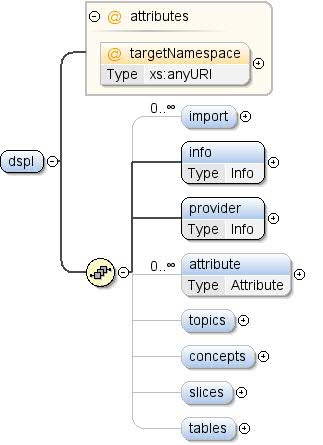 |
| 속성 |
|
| 모델 |
import* , 정보 , provider ,
attribute* , topics{0,1} , 개념{0,1} , 슬라이스{0,1} , 테이블{0,1} |
| 어린이 |
attribute, concepts, import,
정보, 제공자, 슬라이스,
표, 주제 |
| 인스턴스 |
<dspl targetNamespace="">
<import location="" namespace="">{0,unbounded}</import>
<info>{1,1}</info>
<provider>{1,1}</provider>
<attribute concept="" id="">{0,unbounded}</attribute>
<topics>{0,1}</topics>
<concepts>{0,1}</concepts>
<slices>{0,1}</slices>
<tables>{0,1}</tables>
</dspl>
|
| 속성 |
| QName |
유형 |
고정 |
기본값 |
사용 |
Annotation |
| targetNamespace |
xs:anyURI |
|
|
선택사항 |
각 데이터 세트는 대상 네임스페이스를 제공할 수 있습니다. 대상
네임스페이스는 데이터 세트를 고유하게 식별하는 URI입니다. 자세한 내용은
XML에서 네임스페이스 사용에 대한 자세한 내용은 다음을 참조하세요.
http://www.w3.org/TR/REC-xml-names/ 타겟 네임스페이스가 없는 경우
데이터 세트가 작성될 때 네임스페이스가 생성됩니다.
있습니다. |
|
| 소스 |
<xs:element name="dspl">
<xs:annotation>
<xs:documentation>A DSPL specification describes a dataset. A dataset is
identified by its namespace. A dataset is comprised of the
following elements:
- Tables: Data for the concepts and slices defined in the
dataset
- Concepts: User-specified definitions and structures used in
the dataset
- Slices: Combinations of dimensions and metrics present in
the dataset
- Topics: Hierarchical labels used to organise the concepts of
the dataset</xs:documentation>
</xs:annotation>
<xs:complexType>
<xs:sequence>
<xs:element name="import" minOccurs="0" maxOccurs="unbounded">
<xs:annotation>
<xs:documentation>Import directive for external datasets -- modeled after
the XML Schema import directive. In order to use
elements defined in an external dataset, the external
dataset must be referenced using an import directive.</xs:documentation>
</xs:annotation>
<xs:complexType>
<xs:attribute name="namespace" use="required">
<xs:annotation>
<xs:documentation>The namespace of the imported dataset, specified as
a URI. A prefix must be associated with this
namespace before its contents can be referenced. See
[XML Namespaces] for more information about the use
of namespaces and prefixes in XML.</xs:documentation>
</xs:annotation>
</xs:attribute>
<xs:attribute name="location" use="optional">
<xs:annotation>
<xs:documentation>An optional location where the definition of the
imported dataset can be found, specified as a
URL. If the location is omitted, the system
processing this DSPL dataset must already know the
imported dataset.
Implementation note: The Google dataset importer
ignores the location attribute. Any imported dataset
must be known by the Google importer beforehand.</xs:documentation>
</xs:annotation>
</xs:attribute>
</xs:complexType>
</xs:element>
<xs:element name="info" type="Info" minOccurs="1">
<xs:annotation>
<xs:documentation>General information about the dataset.</xs:documentation>
</xs:annotation>
</xs:element>
<xs:element name="provider" type="Info">
<xs:annotation>
<xs:documentation>General information about the dataset provider.</xs:documentation>
</xs:annotation>
</xs:element>
<xs:element name="attribute" type="Attribute" minOccurs="0" maxOccurs="unbounded">
<xs:annotation>
<xs:documentation>Attribute associated with the dataset.</xs:documentation>
</xs:annotation>
</xs:element>
<xs:element name="topics" minOccurs="0">
<xs:annotation>
<xs:documentation>A hierarchy of topics used to organize the contents of
the dataset. The order in which topics are given is
meaningful and should be respected by visualizations
that displays these topics.</xs:documentation>
</xs:annotation>
<xs:complexType>
<xs:sequence>
<xs:element name="topic" type="Topic" maxOccurs="unbounded"/>
</xs:sequence>
</xs:complexType>
</xs:element>
<xs:element name="concepts" minOccurs="0">
<xs:annotation>
<xs:documentation>A list of concepts defined in this dataset.</xs:documentation>
</xs:annotation>
<xs:complexType>
<xs:sequence>
<xs:element name="concept" type="Concept" maxOccurs="unbounded"/>
</xs:sequence>
</xs:complexType>
</xs:element>
<xs:element name="slices" minOccurs="0">
<xs:annotation>
<xs:documentation>A list of slices defined in this dataset.</xs:documentation>
</xs:annotation>
<xs:complexType>
<xs:sequence>
<xs:element name="slice" type="Slice" maxOccurs="unbounded"/>
</xs:sequence>
</xs:complexType>
</xs:element>
<xs:element name="tables" minOccurs="0">
<xs:annotation>
<xs:documentation>A list of tables defined in this dataset.</xs:documentation>
</xs:annotation>
<xs:complexType>
<xs:sequence>
<xs:element name="table" type="Table" maxOccurs="unbounded"/>
</xs:sequence>
</xs:complexType>
</xs:element>
</xs:sequence>
<xs:attribute name="targetNamespace" type="xs:anyURI" use="optional">
<xs:annotation>
<xs:documentation>Each dataset may provide a target namespace. The
target namespace is a URI that uniquely identifies the
dataset. For more information about the use of namespaces in XML,
see:
http://www.w3.org/TR/REC-xml-names/
If no targetNamespace is provided, then a namespace will be
generated when the dataset is imported.</xs:documentation>
</xs:annotation>
</xs:attribute>
</xs:complexType>
</xs:element>
|
요소: dspl / 가져오기
| 네임스페이스 |
http://schemas.google.com/dspl/2010 |
| 주석 |
외부 데이터 세트에 대한 가져오기 지시문 -- XML을 모델링
스키마 가져오기 지시어입니다. 외부
데이터 세트인 경우 가져오기를 사용하여 외부 데이터 세트를 참조해야 합니다.
지시어. |
| 다이어그램 |
 |
| 속성 |
| content: |
복잡함 |
| minOccurs: |
0 |
| maxOccurs: |
unbounded |
|
| 속성 |
| QName |
유형 |
고정 |
기본값 |
사용 |
Annotation |
| location |
|
|
|
선택사항 |
가져온
데이터 세트를 찾을 수 있으며 URL로 지정합니다. 위치가
생략하면 이 DSPL 데이터 세트를 처리하는 시스템은
가져온 데이터 세트입니다 구현 참고사항: Google 데이터 세트
가져오기 도구가 위치 속성을 무시합니다. 가져온 데이터 세트는
Google 수입업체가 사전에 알 수 있어야 합니다. |
| namespace |
|
|
|
필수 |
가져온 데이터 세트의 네임스페이스로,
URI입니다. 네임스페이스에서 접두사를 연결하면 접두사가
참조될 수 있습니다 자세한 내용은 [XML 네임스페이스] 를 참고하세요.
네임스페이스 및 접두사 사용에 대한 정보는
XML입니다. |
|
| 소스 |
<xs:element name="import" minOccurs="0" maxOccurs="unbounded">
<xs:annotation>
<xs:documentation>Import directive for external datasets -- modeled after
the XML Schema import directive. In order to use
elements defined in an external dataset, the external
dataset must be referenced using an import directive.</xs:documentation>
</xs:annotation>
<xs:complexType>
<xs:attribute name="namespace" use="required">
<xs:annotation>
<xs:documentation>The namespace of the imported dataset, specified as
a URI. A prefix must be associated with this
namespace before its contents can be referenced. See
[XML Namespaces] for more information about the use
of namespaces and prefixes in XML.</xs:documentation>
</xs:annotation>
</xs:attribute>
<xs:attribute name="location" use="optional">
<xs:annotation>
<xs:documentation>An optional location where the definition of the
imported dataset can be found, specified as a
URL. If the location is omitted, the system
processing this DSPL dataset must already know the
imported dataset.
Implementation note: The Google dataset importer
ignores the location attribute. Any imported dataset
must be known by the Google importer beforehand.</xs:documentation>
</xs:annotation>
</xs:attribute>
</xs:complexType>
</xs:element>
|
요소: dspl / 정보
| 네임스페이스 |
http://schemas.google.com/dspl/2010 |
| 주석 |
데이터 세트에 대한 일반 정보. |
| 다이어그램 |
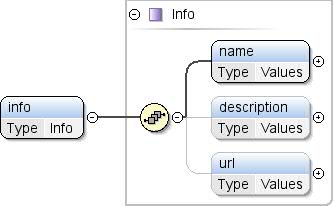 |
| 유형 |
정보 |
| 속성 |
| content: |
복잡함 |
| minOccurs: |
1 |
|
| 모델 |
이름 , 설명{0,1} , URL{0,1} |
| 어린이 |
설명, 이름, url |
| 인스턴스 |
<info>
<name>{1,1}</name>
<description>{0,1}</description>
<url>{0,1}</url>
</info>
|
| 소스 |
<xs:element name="info" type="Info" minOccurs="1">
<xs:annotation>
<xs:documentation>General information about the dataset.</xs:documentation>
</xs:annotation>
</xs:element>
|
요소: dspl / provider
| 네임스페이스 |
http://schemas.google.com/dspl/2010 |
| 주석 |
데이터 세트 제공자에 대한 일반 정보 |
| 다이어그램 |
 |
| 유형 |
정보 |
| 속성 |
|
| 모델 |
이름 , 설명{0,1} , URL{0,1} |
| 어린이 |
설명, 이름, url |
| 인스턴스 |
<provider>
<name>{1,1}</name>
<description>{0,1}</description>
<url>{0,1}</url>
</provider>
|
| 소스 |
<xs:element name="provider" type="Info">
<xs:annotation>
<xs:documentation>General information about the dataset provider.</xs:documentation>
</xs:annotation>
</xs:element>
|
요소: dspl / 속성
| 네임스페이스 |
http://schemas.google.com/dspl/2010 |
| 주석 |
데이터 세트와 연결된 속성입니다. |
| 다이어그램 |
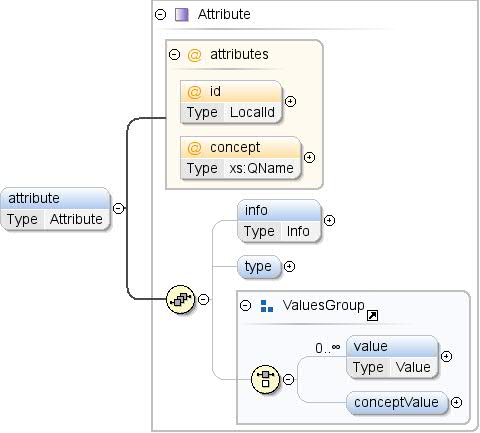 |
| 유형 |
속성 |
| 속성 |
| content: |
복잡함 |
| minOccurs: |
0 |
| maxOccurs: |
unbounded |
|
| 모델 |
info{0,1} , type{0,1} , (값*
| conceptValue{0,1}) |
| 어린이 |
conceptValue, info, type
값 |
| 인스턴스 |
<attribute concept="" id="">
<info>{0,1}</info>
<type format="" ref="">{0,1}</type>
</attribute>
|
| 속성 |
| QName |
유형 |
고정 |
기본값 |
사용 |
Annotation |
| 개념 |
xs:QName |
|
|
선택사항 |
값에 해당하는 개념에 대한 참조입니다.
속성입니다. 속성이 유형을 지정하는 경우 유형은
참조된 개념의 유형과 일치해야 합니다. 참조는
외부 개념은
'prefix:other_concept_id', 여기서 'prefix' 은
외부 데이터 세트의 네임스페이스에 사용되는 프리픽스입니다 (XML 참고).
네임스페이스) |
| id |
LocalId |
|
|
선택사항 |
개념 속성의 ID입니다. 식별자는
특성과 속성에 걸쳐 개념 내에서 고유합니다. 이
concept 속성이 지정된 경우 id는 생략할 수 있습니다. 그 안에서
이 경우 ID는
참조된 개념입니다. 예: <attribute
concept="unit:currency"/> 위 항목은 다음과 동일합니다.
<attribute id="currency"
concept="unit:currency"/> |
|
| 소스 |
<xs:element name="attribute" type="Attribute" minOccurs="0" maxOccurs="unbounded">
<xs:annotation>
<xs:documentation>Attribute associated with the dataset.</xs:documentation>
</xs:annotation>
</xs:element>
|
요소: dspl / topics
| 네임스페이스 |
http://schemas.google.com/dspl/2010 |
| 주석 |
주제의 계층 구조는 뉴스 기사의 콘텐츠를
데이터 세트로 그룹화됩니다. 주제가 주어지는 순서는 의미가 있으므로
이러한 주제를 표시하는 시각화로 존중하는 것을 볼 수 있습니다. |
| 다이어그램 |
 |
| 속성 |
| content: |
복잡함 |
| minOccurs: |
0 |
|
| 모델 |
주제+ |
| 어린이 |
주제 |
| 인스턴스 |
<topics>
<topic id="" parentTopic="">{1,unbounded}</topic>
</topics>
|
| 소스 |
<xs:element name="topics" minOccurs="0">
<xs:annotation>
<xs:documentation>A hierarchy of topics used to organize the contents of
the dataset. The order in which topics are given is
meaningful and should be respected by visualizations
that displays these topics.</xs:documentation>
</xs:annotation>
<xs:complexType>
<xs:sequence>
<xs:element name="topic" type="Topic" maxOccurs="unbounded"/>
</xs:sequence>
</xs:complexType>
</xs:element>
|
| 네임스페이스 |
http://schemas.google.com/dspl/2010 |
| 다이어그램 |
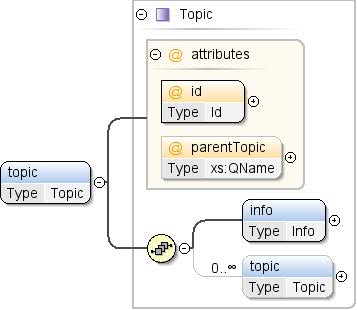 |
| 유형 |
주제 |
| 속성 |
| content: |
복잡함 |
| maxOccurs: |
unbounded |
|
| 모델 |
정보 , 주제* |
| 어린이 |
정보, 주제 |
| 인스턴스 |
<topic id="" parentTopic="">
<info>{1,1}</info>
<topic id="" parentTopic="">{0,unbounded}</topic>
</topic>
|
| 속성 |
| QName |
유형 |
고정 |
기본값 |
사용 |
Annotation |
| id |
ID |
|
|
필수 |
데이터 세트입니다 |
| parentTopic |
xs:QName |
|
|
선택사항 |
이 주제에 상위 주제가 있는 경우, 그 ID입니다.
내부에 인라인된 주제에는 parentTopic을 지정할 수 없습니다.
다른 주제도 살펴보세요. |
|
| 소스 |
<xs:element name="topic" type="Topic" maxOccurs="unbounded"/>
|
요소: dspl / 개념
| 네임스페이스 |
http://schemas.google.com/dspl/2010 |
| 주석 |
이 데이터 세트에 정의된 개념 목록입니다. |
| 다이어그램 |
 |
| 속성 |
| content: |
복잡함 |
| minOccurs: |
0 |
|
| 모델 |
개념+ |
| 어린이 |
개념 |
| 인스턴스 |
<concepts>
<concept extends="" id="">{1,unbounded}</concept>
</concepts>
|
| 소스 |
<xs:element name="concepts" minOccurs="0">
<xs:annotation>
<xs:documentation>A list of concepts defined in this dataset.</xs:documentation>
</xs:annotation>
<xs:complexType>
<xs:sequence>
<xs:element name="concept" type="Concept" maxOccurs="unbounded"/>
</xs:sequence>
</xs:complexType>
</xs:element>
|
| 네임스페이스 |
http://schemas.google.com/dspl/2010 |
| 다이어그램 |
 |
| 유형 |
개념 |
| 속성 |
| content: |
복잡함 |
| maxOccurs: |
unbounded |
|
| 모델 |
info , topic* , type{0,1} ,
attribute* , property* , defaultValue{0,1} , table{0,1} |
| 어린이 |
attribute, defaultValue, info,
속성, 표, 주제,
유형 |
| 인스턴스 |
<concept extends="" id="">
<info>{1,1}</info>
<topic ref="">{0,unbounded}</topic>
<type ref="">{0,1}</type>
<attribute concept="" id="">{0,unbounded}</attribute>
<property concept="" id="" isMapping="false" isParent="false">{0,unbounded}</property>
<defaultValue>{0,1}</defaultValue>
<table ref="">{0,1}</table>
</concept>
|
| 속성 |
| QName |
유형 |
고정 |
기본값 |
사용 |
Annotation |
| 확장 |
xs:QName |
|
|
선택사항 |
이 개념이 제공하는 개념의 고유 식별자입니다.
확장됩니다. 참조된 개념이 동일한 데이터 세트에 정의될 수 있습니다.
데이터를 공유할 수 있습니다 외부
개념은 'prefix:other_concept_id' 형식이어야 합니다.
여기서 'prefix' 는
외부 데이터 세트 (XML 네임스페이스 참고) |
| id |
ID |
|
|
필수 |
개념의 고유 식별자로서
데이터 세트 내에서 전역적으로 고유합니다. |
|
| 소스 |
<xs:element name="concept" type="Concept" maxOccurs="unbounded"/>
|
요소: dspl / 슬라이스
| 네임스페이스 |
http://schemas.google.com/dspl/2010 |
| 주석 |
이 데이터 세트에 정의된 슬라이스 목록입니다. |
| 다이어그램 |
 |
| 속성 |
| content: |
복잡함 |
| minOccurs: |
0 |
|
| 모델 |
슬라이스+ |
| 어린이 |
slice |
| 인스턴스 |
<slices>
<slice id="">{1,unbounded}</slice>
</slices>
|
| 소스 |
<xs:element name="slices" minOccurs="0">
<xs:annotation>
<xs:documentation>A list of slices defined in this dataset.</xs:documentation>
</xs:annotation>
<xs:complexType>
<xs:sequence>
<xs:element name="slice" type="Slice" maxOccurs="unbounded"/>
</xs:sequence>
</xs:complexType>
</xs:element>
|
| 네임스페이스 |
http://schemas.google.com/dspl/2010 |
| 다이어그램 |
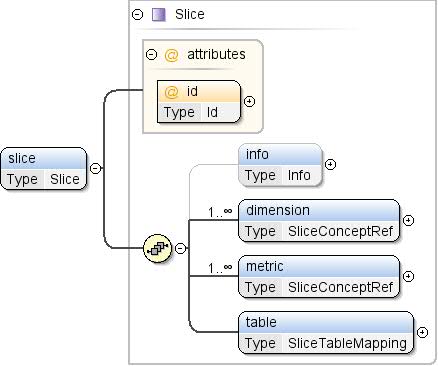 |
| 유형 |
슬라이스 |
| 속성 |
| content: |
복잡함 |
| maxOccurs: |
unbounded |
|
| 모델 |
info{0,1} , 측정기준+ , 측정항목+
, 표 |
| 어린이 |
측정기준, 정보, 측정항목
표 |
| 인스턴스 |
<slice id="">
<info>{0,1}</info>
<dimension concept="">{1,unbounded}</dimension>
<metric concept="">{1,unbounded}</metric>
<table ref="">{1,1}</table>
</slice>
|
| 속성 |
| QName |
유형 |
고정 |
기본값 |
사용 |
Annotation |
| id |
ID |
|
|
필수 |
슬라이스의 고유 식별자입니다. |
|
| 소스 |
<xs:element name="slice" type="Slice" maxOccurs="unbounded"/>
|
요소: dspl / 테이블
| 네임스페이스 |
http://schemas.google.com/dspl/2010 |
| 주석 |
이 데이터 세트에 정의된 테이블 목록입니다. |
| 다이어그램 |
 |
| 속성 |
| content: |
복잡함 |
| minOccurs: |
0 |
|
| 모델 |
표+ |
| 어린이 |
표 |
| 인스턴스 |
<tables>
<table id="">{1,unbounded}</table>
</tables>
|
| 소스 |
<xs:element name="tables" minOccurs="0">
<xs:annotation>
<xs:documentation>A list of tables defined in this dataset.</xs:documentation>
</xs:annotation>
<xs:complexType>
<xs:sequence>
<xs:element name="table" type="Table" maxOccurs="unbounded"/>
</xs:sequence>
</xs:complexType>
</xs:element>
|
| 네임스페이스 |
http://schemas.google.com/dspl/2010 |
| 다이어그램 |
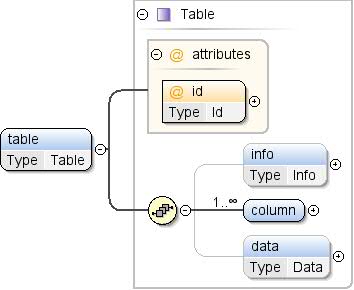 |
| 유형 |
표 |
| 속성 |
| content: |
복잡함 |
| maxOccurs: |
unbounded |
|
| 모델 |
info{0,1} , column+ , data{0,1} |
| 어린이 |
열, 데이터, 정보 |
| 인스턴스 |
<table id="">
<info>{0,1}</info>
<column format="" id="" type="">{1,unbounded}</column>
<data>{0,1}</data>
</table>
|
| 속성 |
| QName |
유형 |
고정 |
기본값 |
사용 |
Annotation |
| id |
ID |
|
|
필수 |
데이터 세트입니다 |
|
| 소스 |
<xs:element name="table" type="Table" maxOccurs="unbounded"/>
|
| 네임스페이스 |
네임스페이스 없음 |
| 주석 |
URI로 지정된 가져온 데이터 세트의 네임스페이스입니다. 가
접두사를 이 네임스페이스와 연결해야 내용을 편집할 수 있습니다.
참조됩니다. 다음 항목의 사용에 대한 자세한 내용은 [XML 네임스페이스] 를 참조하세요.
네임스페이스와 접두사를 모두 지원합니다. |
| 속성 |
|
| 사용 주체 |
|
| 소스 |
<xs:attribute name="namespace" use="required">
<xs:annotation>
<xs:documentation>The namespace of the imported dataset, specified as
a URI. A prefix must be associated with this
namespace before its contents can be referenced. See
[XML Namespaces] for more information about the use
of namespaces and prefixes in XML.</xs:documentation>
</xs:annotation>
</xs:attribute>
|
| 네임스페이스 |
네임스페이스 없음 |
| 주석 |
가져온
데이터 세트를 찾을 수 있으며 URL로 지정합니다. 위치가 생략된 경우
이 DSPL 데이터 세트를 처리하는 시스템은 가져온
데이터 세트로 그룹화됩니다. 구현 참고사항: Google 데이터 세트 가져오기 도구는
location 속성입니다. 가져온 모든 데이터 세트는 Google
사전에 가져오는 것이 좋습니다. |
| 속성 |
|
| 사용 주체 |
|
| 소스 |
<xs:attribute name="location" use="optional">
<xs:annotation>
<xs:documentation>An optional location where the definition of the
imported dataset can be found, specified as a
URL. If the location is omitted, the system
processing this DSPL dataset must already know the
imported dataset.
Implementation note: The Google dataset importer
ignores the location attribute. Any imported dataset
must be known by the Google importer beforehand.</xs:documentation>
</xs:annotation>
</xs:attribute>
|
속성: dspl / @targetNamespace
| 네임스페이스 |
네임스페이스 없음 |
| 주석 |
각 데이터 세트는 대상 네임스페이스를 제공할 수 있습니다. 대상
네임스페이스는 데이터 세트를 고유하게 식별하는 URI입니다. 자세한 내용은
XML에서 네임스페이스 사용에 대한 자세한 내용은 다음을 참조하세요.
http://www.w3.org/TR/REC-xml-names/ targetNamespace를 입력하지 않은 경우
데이터세트가 생성될 때 네임스페이스가 생성됩니다.
있습니다. |
| 유형 |
xs:anyURI |
| 속성 |
|
| 사용 주체 |
|
| 소스 |
<xs:attribute name="targetNamespace" type="xs:anyURI" use="optional">
<xs:annotation>
<xs:documentation>Each dataset may provide a target namespace. The
target namespace is a URI that uniquely identifies the
dataset. For more information about the use of namespaces in XML,
see:
http://www.w3.org/TR/REC-xml-names/
If no targetNamespace is provided, then a namespace will be
generated when the dataset is imported.</xs:documentation>
</xs:annotation>
</xs:attribute>
|
다음을 사용하여 생성:
oXygen XML 편집기.
달리 명시되지 않는 한 이 페이지의 콘텐츠에는 Creative Commons Attribution 4.0 라이선스에 따라 라이선스가 부여되며, 코드 샘플에는 Apache 2.0 라이선스에 따라 라이선스가 부여됩니다. 자세한 내용은 Google Developers 사이트 정책을 참조하세요. 자바는 Oracle 및/또는 Oracle 계열사의 등록 상표입니다.
최종 업데이트: 2025-07-25(UTC)
[null,null,["최종 업데이트: 2025-07-25(UTC)"],[],["The DSPL XML schema defines a dataset's structure using key components: `tables`, `concepts`, `slices`, and `topics`. The root `dspl` element encapsulates the dataset, utilizing `import` to reference externals, `info` and `provider` for metadata, `attribute` for dataset attributes, and `topics` to hierarchically organize the concepts. `concepts`, `slices`, `tables` are for concept definition, slice definition, and data table, respectively. Each element like `import`, `info`, `provider`, `attribute`, `topic`, `concept`, `slice`, `table` uses specific attributes and child elements for configuration. Each element has a specific cardinality that is defined in the document.\n"]]












